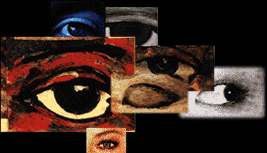

 |
 |
||||||
|
"The visual arts and the experimental sciences travel along parallel lines founded upon a generalization of the mechanism of vision, thanks to the combined and repeated interaction between experience and imagination, the result being an ensemble of signs able to offer an immediately recognizable sense… When we speak of ‘vision’, we also mean the simultaneous evaluation of events stored in the brain." (Careri,1989) The quest for the most aesthetic, quintessential piece of visual pleasure has always been foremost in the eyes of all artists and layman. The statement "beauty is in the eyes of the beholder" seems somewhat related to the Golden Mean. Literally, this rings true when you study the physiological function of the eye itself. Through focus and movement, the human eye has the ability to send signals to the brain while calculating angles, distance, color and motion. When we look out onto the world our depth of vision, or "visual limit, the field of overlap for the percepts of each eye", as stated in works by Boursalavitch(1958), has been found to be very close to the golden mean value. The dimensions of fields in which we can perceive color comes to 1.16018. Also the human field of binocular vision is 1.665. "When we look out on the world, our view of it is framed by the overall limits of our peripheral vision and the centre-line of the eye in its vertical axis is set almost exactly on its ‘golden mean’. Moreover, the horizontal axis cuts the maximum eye movement zone, again on its ‘golden mean’ (if we take the horizontal axis to be the centre-line between the upper and lower limits of our peripheral vision, that is the centre-line of our overall field of view which, coincidentally is the normal declination of the fovea, (area of sharpest visual acuity) when standing ‘attentive’)…our overall view of the world is still framed by the proportion of a golden rectangle."(Avery,1994) A work of art’s sense is the psychological feeling or, to be more precise, the emotion that the work provokes in us." (Careri,1989) "Beauty arouses emotion…The aesthetic experience is an emotional, rather than a rational mental activity." (Huntley,1970) According to these statements it is thought that the "collective unconscious", as referred to by Jung is instinctive behavior we all possess. This instinctive behavior is inherited and is determined by the history of race. Jung calls these "primordial images" or "archetypes," which were formed tens of thousands of years ago during the evolutionary process, determining factors that form our present reactions. The definition of "the collective unconscious, being the inheritance of the possibilities of ideas, is not individual but generally human, generally animal even, and represents the real foundation of the individual soul….From the collective unconscious as a timeless universal mind we should expect reactions to the most universal and constant conditions, whether psychological, physiological or physical. From the conscious, on the other hand, we should expect reactions and adaptation phenomena relating to the present: for the conscious is that part of the mind that is preferably limited to events of the moment." (Jung,1927) Clearly a visual intuition is derived from the combination of these ideas. The viewer of beauty will naturally gravitate to the familiar. The instinctual feeling is calming, good, and comfortable. Therefore, one is attracted to the aesthetics or niceties of the visual. When considering a work of art, the viewer is experiencing the emotions that the artist experienced when creating the piece. Beauty is definitely contained within the eye and the soul of the beholder. |